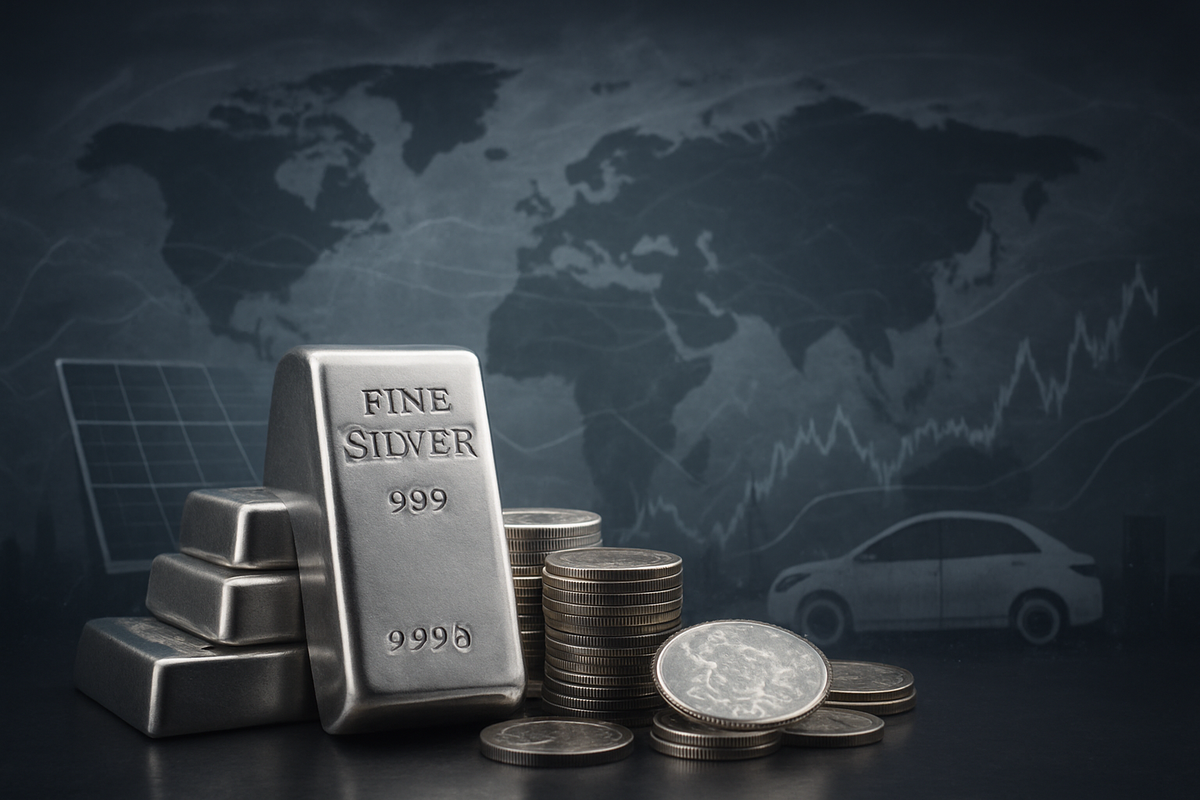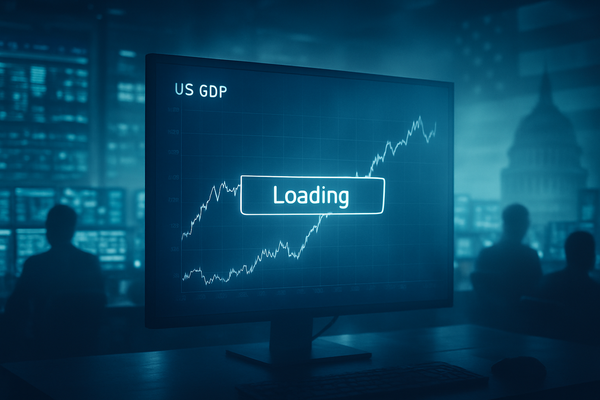Silver Shines Bright: XAG Holds Near $49.10 as Global Volatility Fuels Safe-Haven Demand

London, UK – October 31, 2025 – Silver (XAG) is currently holding its ground near $49.10 per ounce, a testament to its enduring appeal amidst a landscape of heightened global market volatility. This remarkable resilience comes after the precious metal touched an all-time nominal high of $54.49 earlier in October, marking a significant rally throughout 2025. The metal's performance underscores its dual nature: a critical industrial commodity essential for the burgeoning green economy and a traditional safe-haven asset sought by investors wary of economic uncertainty and geopolitical instability.
The sustained interest in silver reflects a broader sentiment of caution pervading financial markets. From geopolitical flashpoints and persistent inflation to central bank policy shifts and a prolonged U.S. government shutdown, a confluence of factors is driving investors towards tangible assets. While silver has experienced some profit-taking corrections from its recent peaks, its ability to quickly rebound and consolidate near the $49 mark indicates strong underlying demand and a bullish long-term outlook.
Silver's Ascent: A Detailed Account of Market Dynamics
The journey of silver to its current elevated price point has been nothing short of dramatic. After closing 2024 around $28.94 per ounce, XAG began a rapid ascent in early 2025, breaching the $30 mark by January 7th. This momentum continued through the first half of the year, fueled by robust industrial demand and tightening physical supply, pushing prices past $37.44 by August 4th. The rally accelerated sharply in October 2025, with silver not only surpassing $49 and $50 but briefly touching an all-time nominal high of approximately $54.49 per ounce in London markets. On October 31, 2025, silver traded at $49.09, reflecting a recovery from a sharp 16% correction that saw it dip to around $45.56.
Several critical factors have converged to ignite this unprecedented surge and volatility. Economically, persistent U.S. inflation (remaining elevated at 3% year-over-year in September 2025), coupled with expectations of aggressive interest rate cuts by central banks like the Federal Reserve, has significantly boosted silver's appeal as an inflation hedge and reduced the opportunity cost of holding non-yielding assets. Geopolitically, the escalation of the Russia-Ukraine conflict, persistent Middle East regional tensions, and heightened trade disputes between major economies have created a global environment ripe for safe-haven flows. Structurally, the market faces a chronic supply deficit, with 2025 marking the fifth consecutive year where demand has outstripped supply, driven by insatiable industrial demand from solar photovoltaics, electric vehicles (EVs), and advanced electronics.
Key players in the silver market have reacted accordingly. Major producers like Fresnillo plc (LSE: FRES), Pan American Silver Corp. (NASDAQ: PAAS), and First Majestic Silver Corp. (NYSE: AG) are direct beneficiaries, with many expanding operations or reporting increased production. For instance, First Majestic Silver reported a nearly 76% Q2 2025 silver production spike. Institutional investors have poured capital into silver-backed Exchange-Traded Products (ETPs), with record net inflows in the first half of 2025. Financial institutions, including major trading banks, navigate both opportunities from volatility and risks associated with tight physical supply and short positions in the London market.
Corporate Fortunes: Winners and Losers in a High-Silver Market
The sustained price of silver near $49.10 per ounce, driven by safe-haven demand and robust industrial use, creates distinct winners and losers among public companies.
Silver Mining Companies are unequivocally the primary beneficiaries. Higher silver prices directly translate to increased revenues and significantly enhanced profit margins, as fixed operating costs remain relatively stable. Companies like Hecla Mining Company (NYSE: HL), the largest U.S. silver producer, and streaming and royalty companies such as Wheaton Precious Metals Corp. (NYSE: WPM), which benefit from higher realized prices without direct operational risks, are seeing boosted cash flows and valuations. This environment encourages miners to accelerate exploration, optimize existing operations, and strengthen balance sheets, potentially leading to increased dividends and M&A activity within the sector. Other notable winners include Santacruz Silver Mining Ltd. (OTCPK: SCZMF), Coeur Mining (NYSE: CDE), Endeavour Silver Corp. (NYSE: EXK), Aya Gold and Silver (TSX: AYA:CA), Silvercorp Metals (NYSE: SVM), and Vizsla Silver (NYSE: VZLA).
Conversely, Industrial Users of Silver face significant challenges. Silver is a critical component in numerous high-tech applications, and a price near $49.10 per ounce substantially increases raw material costs. Solar panel manufacturers, for instance, see silver accounting for a growing portion of their production costs. Companies like First Solar, Inc. (NASDAQ: FSLR), while benefiting from lower prices, would face headwinds from sustained high costs. Similarly, electronics manufacturers (including those for 5G infrastructure, EVs, and AI hardware) and jewelry manufacturers will experience squeezed profit margins unless they can fully pass on these costs to consumers. These industries are intensifying efforts to reduce silver content (known as "thrifting") or explore alternative materials, though widespread substitution is difficult due to silver's unique properties.
Companies Involved in Precious Metals Investment generally benefit from increased investor interest. Providers of silver-backed ETFs, such as iShares Silver Trust (NYSEARCA: SLV) and abrdn Physical Silver Shares ETF (SIVR), see their assets under management (AUM) swell, leading to higher management fees. ETFs focused on silver mining companies like Global X Silver Miners ETF (NYSEARCA: SIL) and ETFMG Prime Junior Silver ETF (NYSEARCA: SILJ) offer leveraged exposure to silver price movements, attracting significant capital inflows during bull markets. Precious metals investment firms also experience increased client interest as investors seek safe-haven assets.
Wider Significance: Ripples Across Global Markets
Silver's strong performance near $49.10 per ounce, driven by safe-haven demand, carries profound wider significance for global financial markets, echoing periods of past instability.
This trend fits squarely into a broader bullish outlook for precious metals. When silver rallies, gold often follows suit, both benefiting from heightened geopolitical risks, inflation concerns, and a weakening U.S. dollar. The gold-silver ratio, which measures how many ounces of silver it takes to buy one ounce of gold, often indicates silver's relative undervaluation, suggesting potential for silver to outperform gold in percentage terms during strong rallies. Unlike gold, silver's substantial industrial demand from the "green economy" (solar, EVs, 5G, AI) provides an additional, robust layer of support, making its price dynamics unique.
The ripple effects extend to other commodities. A strong silver price, especially when industrial demand is high, can initially signal robust activity in sectors reliant on industrial metals like copper, which is also critical for electrification. However, if safe-haven demand is primarily driven by fears of an economic downturn, it could eventually depress demand for other industrial commodities. Generally, commodity prices tend to retain value better than paper assets during inflationary periods, indicating a broader inflationary environment. On currencies, precious metals often move inversely to the US dollar. A weakening dollar, often a consequence of anticipated rate cuts or U.S. fiscal uncertainty, makes dollar-denominated silver more attractive, thus boosting its price. Conversely, this environment often sees appreciation in other traditional safe-haven currencies like the Japanese Yen (JPY) and Swiss Franc (CHF).
For global financial markets, a strong rally in safe-haven assets like silver typically signals a "risk-off" sentiment, leading to increased volatility or declines in equity markets as investors rebalance portfolios. This could prompt central banks to adjust monetary policy in response to commodity-driven inflation or capital flows. Historically, silver's surges to near $50 per ounce in 1980 and 2011 occurred amidst similar backdrops of high inflation, geopolitical tensions, and economic uncertainty. The current environment on October 31, 2025, shares these characteristics, but with the added dynamic of a powerful green energy industrial demand component, suggesting a more fundamental and sustainable upward pressure on silver prices.
What Comes Next: Navigating Silver's Future Trajectory
The future trajectory for silver, while promising, is expected to remain dynamic and volatile. In the short-term (next few months), silver is likely to consolidate within a broad range, perhaps between $40 and $60 per ounce, as profit-taking tempers further immediate surges. However, strong underlying industrial and safe-haven demand is expected to provide robust support against significant pullbacks. Key short-term influencers will be ongoing geopolitical developments, central bank monetary policy signals (especially from the Federal Reserve), and real-time industrial demand data.
The long-term outlook (next few years) for silver is overwhelmingly bullish. Driven by an accelerating "industrial super-cycle" fueled by the green energy transition (solar, EVs, AI), industrial demand is projected to soar, potentially absorbing over 20% of current annual silver supply by 2027. This, coupled with persistent structural supply deficits (the cumulative shortfall from 2021-2025 alone is nearly 800 million ounces) and chronic underinvestment in mine exploration, sets the stage for significant price appreciation. Many analysts forecast silver to reach $70-$100 per ounce by 2030, with some even predicting $140 or higher, making it a compelling long-term investment.
Strategic pivots and adaptations will be crucial for market participants. Investors should consider silver for portfolio diversification and as a hedge against inflation, using short-term corrections as strategic entry points for long-term positions. Monitoring ETF flows, physical inventories, and real yields will be vital. Mining companies must capitalize on higher prices by accelerating exploration and optimizing production, while also navigating geopolitical risks in key producing regions. Industrial users will need to secure long-term supply agreements, invest in recycling technologies, and continue efforts to "thrift" (reduce) silver content in their products to mitigate rising input costs.
Emerging opportunities include the continued expansion of the green economy, which guarantees a baseline of strong industrial demand, and the potential for previously uneconomical silver deposits to become viable. Challenges include persistent supply chain disruptions, the inelastic nature of silver supply (as a byproduct metal), and the continuous innovation by manufacturers to reduce silver usage. Potential scenarios range from a continued bullish surge towards $100+ per ounce by 2030, driven by deepening deficits and accelerating green tech demand, to a moderate growth and consolidation scenario, or a less likely but possible significant pullback if speculative positioning unwinds sharply or global demand falters.
Wrap-Up: Silver's Enduring Significance and Investor Watchpoints
As of October 31, 2025, silver's performance near $49.10 per ounce underscores its critical role in the global financial landscape. Its remarkable rally throughout the year, culminating in an all-time high earlier in the month, is a clear indicator of its growing significance as both a safe-haven asset and an indispensable industrial metal. The persistent safe-haven demand, fueled by geopolitical instability, inflationary pressures, and central bank monetary policies, combined with an insatiable appetite from the green energy revolution, has created a powerful dual engine for silver's price appreciation.
Looking ahead, the silver market is poised for continued strength, albeit with characteristic volatility. The structural supply deficits are not easily resolved, and industrial demand from solar, EVs, and advanced electronics is only projected to accelerate. This fundamental imbalance, coupled with ongoing macroeconomic uncertainties, points towards a sustained bullish trend for silver in the medium to long term. The recent corrections should be viewed as healthy consolidations within a larger uptrend rather than a reversal.
Investors should closely monitor several key indicators in the coming months. These include shifts in Federal Reserve policy regarding interest rates, which directly impact the attractiveness of non-yielding assets. Geopolitical developments and U.S.-China trade relations will continue to dictate safe-haven flows. Crucially, tracking industrial demand trends from the green economy and monitoring global silver inventories will provide insights into the underlying supply-demand dynamics. Finally, the strength of the U.S. dollar and technical price levels will offer immediate guidance for navigating silver's inherent volatility. Silver is not merely a hedge; it is becoming a cornerstone of the future economy.
This content is intended for informational purposes only and is not financial advice



